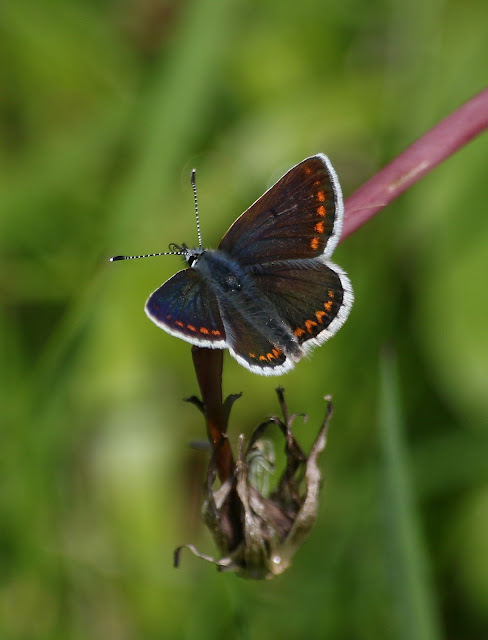Powerstock Common used to be one of my favourite places to visit, especially to look for Marsh Fritillary and Narrow-bordered Bee Hawk Moth. Back in 2023 I thought it would be a great place to go now that I have to use a mobility scooter a good deal of the time. It has a disused railway line and other good tracks that are relatively level too. It was indeed ideal for getting about on my scooter which has some 'off road' capability but even so I was very disappointed in the state of the place.
The first thing I noticed is that they have a brand new information sign near the entrance which suspiciously doesn't mention the Marsh Fritillary any more. They had always been in low numbers so I assume they are probably extinct at the site now. I certainly didn't see any and even more disappointing is that I couldn't find Narrow-bordered Bee Hawk Moth either. What the site does have is a large herd of cattle roaming freely. Too many of them if you ask me, but I'm no expert. The railway cutting area which is usually awash with wildflowers including orchids,was only awash with cow pats and smelt terrible. Almost all of the Common Twayblades I could locate had been bitten off as had many other palatable flowers. I realise that grazing is important but I don't think all year round cattle is the right choice.
Before writing this I have done a bit of research and found that the last sightings of Marsh Fritillary appear to have been four in 2019 and just one in 2020 with none since. Having said all that I did see a few nice bee species including the scarce Long-horned Bee, Red-Tailed Mason Bee, (a.k.a. The Broomstick Bee) and Gold-fringed Mason Bee.
Anyway, here are some photos of what I did see on two visits in mid and late May. I did have some of the habitat but they were lost in the hard drive incident mentioned in my previous post.
Brown Argus - Aricia agestis
Grizzled Skipper - Pyrgus malvae
Red-tailed Mason Bee - Osmia bicolor
Here she is carrying a stick about 4x her length. It can bee tricky to see where the stick ends due to the cluttered background, so below I've isolated her from the background so it easier to see this.
She uses these sticks and pieces of grass to hide the snail shell which has her nest in it.
Gold-fringed Mason Bee - Osmis aurulenta
Long-horned Bee (female) - Eucera longicornis
Green Tiger Beetle - Cicindela campestris
Hairy Shieldbug - Dolycoris baccarum











2 comments:
Hi Karen, it's good to see some new posts on here. 😊
The first time I went to Powerstock Common looking for butterflies was the late May Bank Holiday in 2020, and I photographed two different Marsh Fritillaries. They are still the only Marsh Frits I've seen there. A bit sad really...
It certainly is......You probably saw the last ones.
Post a Comment